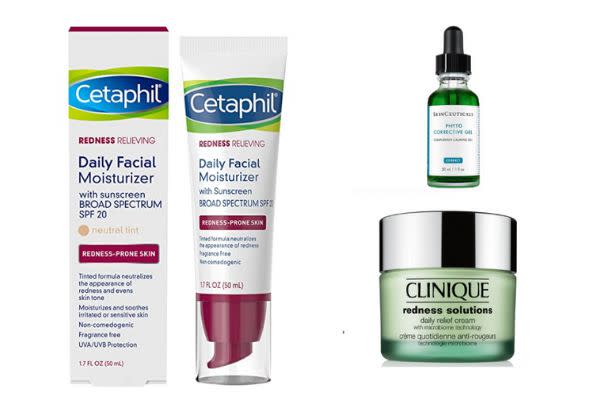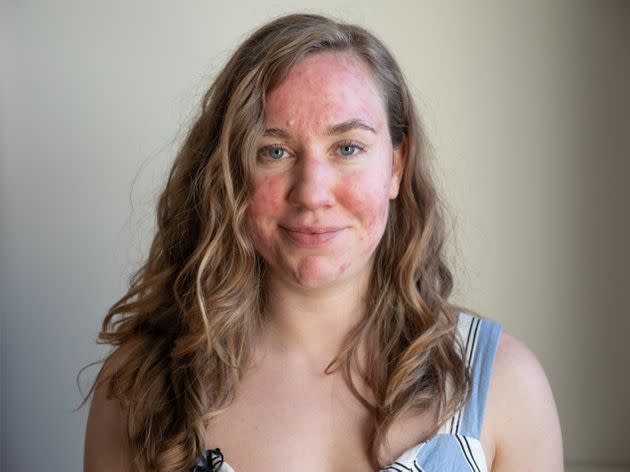The Best Over-The-Counter Products To Treat Rosacea

Rosacea (pronounced roe-ZAY-she-uh) is more common than most people think. Characterized by redness on the face, rosacea is a chronic inflammatory skin condition that typically affects people across the most central part of the face (nose, cheeks, chin), and it can be aggravated by several triggers.
Unfortunately, rosacea is often left untreated, as people may not realize they have it. The condition affects about 16 million Americans and as many as 415 million people worldwide — and the National Rosacea Society found that 95% of rosacea patients knew little or nothing about the signs or symptoms of the condition before their diagnosis.
Why do some people have rosacea and others don’t? Dr. Dendy Engelman, a cosmetic dermatologist and Mohs surgeon in the Shafer Clinic in New York City, said it has to do with our immune system and the microorganisms in our skin.
“We all have living microorganisms on our skin, which help keep us healthy and fight bad bacteria,” she said. “However, in patients with rosacea, the body’s immune system recognizes these microorganisms as potential threats and springs into action to combat them.”
There are many triggers that differ from person to person, but the most common ones are spicy food, sun, fragranced skin care, alcohol, extreme temperatures and exercise.
Types of rosacea
There are four main subtypes of rosacea, and people can have more than one. These are:
Erythematotelangiectatic rosacea: persistent redness of the skin, flushing, broken blood vessels
Papulopustular rosacea: pus-filled blemishes (pustules), often misdiagnosed as acne, that appear on the cheeks, chin, forehead and sometimes on the neck, chest or scalp
Phymatous rosacea: a rare but treatable type of rosacea where there is thickening of the skin, usually on the nose
Ocular rosacea: gritty eyes that can be burning and look watery or bloodshot
People of all skin types can get rosacea, but it’s mostly commonly seen on people with light skin. Darker skin tones also can experience rosacea; however, Dr. Michelle Henry, a board-certified dermatologist, founder of Skin & Aesthetic Surgery in Manhattan and clinical instructor at Weill Cornell College of Dermatology, said some practitioners may not be used to diagnosing it on darker skin.
How to recognize rosacea
To the untrained eye, rosacea can often be misunderstood for acne, which is why it’s important to get a professional opinion.
“The common skin findings include broken blood vessels and pimple-like bumps,” said Dr. Claire Wolinsky, a medical and cosmetic dermatologist at Berkowitz Dermatology in New York City.
The positioning of these pustules also helps differentiate it from acne. They’re all over the face with acne, Wolinksy said, but are across the central parts of the face with rosacea. Acne is also characterized by blackheads and whiteheads, which aren’t indicative of rosacea.
The condition is often painful. Sometimes a burning sensation is present, especially during a flare-up.
Engelman said to look out for symptoms such as “unusual warmth or sensitivity in the face; dry, swollen and/or patchy skin; blemishes that do not go away with acne treatment; hard yellow-brown bumps near the mouth or eyes; swollen or thickening skin on the face.”

Common myths and misconceptions
Lasers can cure rosacea:“There is no cure for rosacea ... lasers can help reduce redness, but only with continued use, which can become costly,” Wolinsky said.
Rosacea is contagious: “Even during a flare-up, you can’t pass it to someone else through contact, inhalation or any other means,” Engelman said. “Rosacea is thought to be genetic, or develop in individuals through certain triggers.”
Creams, potions and lotions can help with all types of rosacea: Wolinsky said prescription products are ideal for the acne subtype of rosacea, but won’t do much for the other cases. “For the redness and broken blood vessels, sometimes good makeup and sunscreen are the best option,” she said.
Rosacea is caused or worsened by poor hygiene: “Rosacea is a condition that is unrelated to personal hygiene,” Engelman said. “However, too much rubbing or scrubbing, or the use of irritating ingredients, can worsen rosacea symptoms. Those who have rosacea should be extra vigilant about their skin care products and routine.”
Sun is good for rosacea: “While blue light/visible light can be anti-inflammatory, UV rays are harmful to the skin and cause skin cancer. Sun can also be a trigger for rosacea, so it’s best to avoid and protect from exposure of the skin to the sun,” Wolinsky said.
Overall, rosacea is a complicated condition and the advice of professionals is vital. It’s important to know and understand your own personal triggers — keeping a listing can be very helpful — and avoid them as much as possible. Read on for the over-the-counter rosacea recommendations from the experts.
Expert-Recommended Products For Rosacea
HuffPost may receive a share from purchases made via links on this page. Prices and availability subject to change.
This article originally appeared on HuffPost and has been updated.



